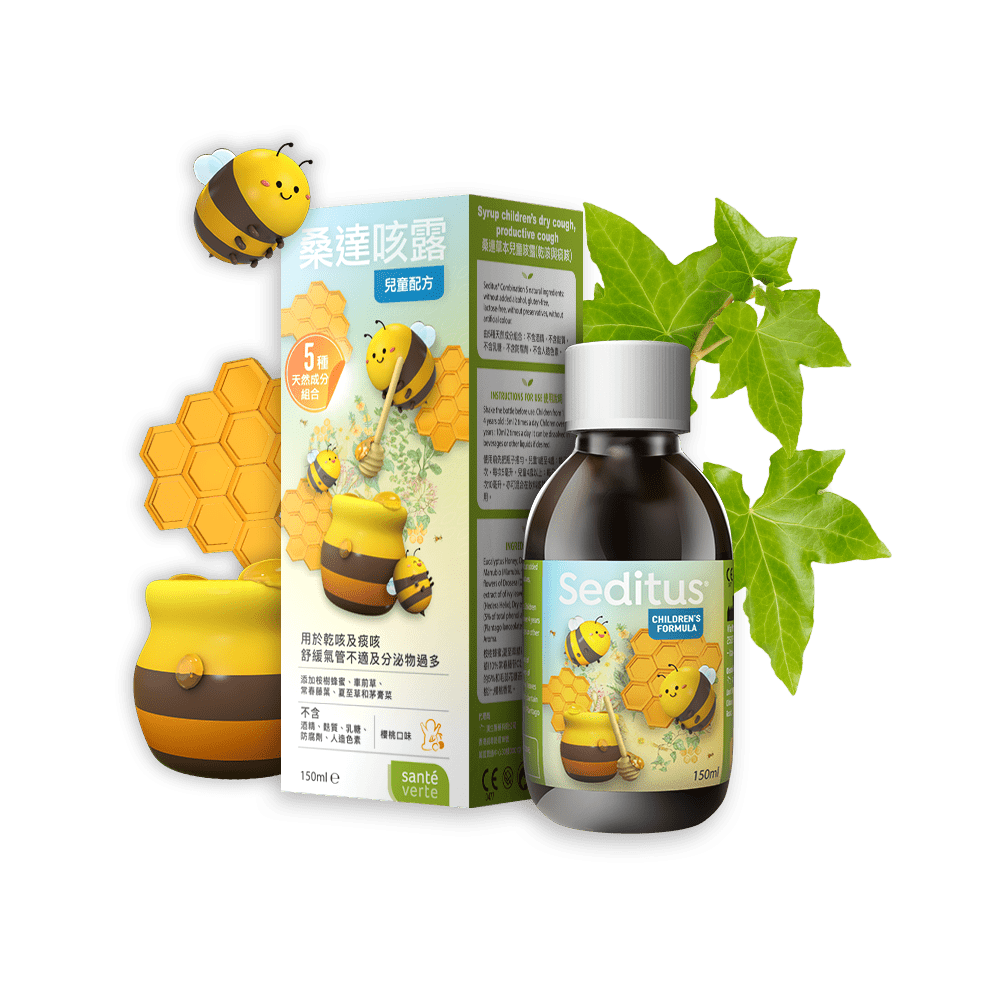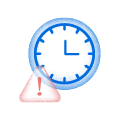01 / 03
Seditus® Children's Cough
by Sante Verte
IntroductionMedication Usage
Seditus CHILDREN’S FORMULA
Ingredient Introduction
1.Eucalyptus honey
- Research has shown a significant improvement in nighttime cough and sleep difficulties associated with upper respiratory infections (URI) in children when comparing a single dose of three types of honey products (eucalyptus honey, citrus honey, or labiatae honey) to a placebo.
- Eucalyptus honey can alleviate symptoms of nighttime cough and sleep difficulties in children caused by URI.
2.Drosera rotundifolia L
- Since ancient times, Drosera rotundifolia syrup primarily composed of Drosera rotundifolia has been used to help clear respiratory mucus, enhance ciliary activity in the respiratory tract, and aid in expectoration and relieving cough.
- Drosera rotundifolia’s general effects on the respiratory system are described in homeopathy materia medica, including its use for excessive phlegm, spasmodic, paroxysmal, dry, and irritative coughs, similar to whooping cough. This plant is often a component of homeopathic formulations used to treat complex upper respiratory conditions.
- Clinical studies have analyzed the efficacy of such therapies in alleviating symptoms or improving quality of life, and have reported positive outcomes.
3.Marrubium vulgare L
- It can moisturize and protect the respiratory tract, aiding in improving symptoms of chronic cough.
- It helps to relax bronchial secretions and eliminate mucus.
4.Plantago lanceolate L
- Plantain is used to treat upper respiratory tract infections. Experimental research has confirmed its anti-inflammatory, antispasmodic, and immune-stimulating effects.
- Plantain has shown significant results in alleviating moderate chronic irritative cough and can relieve cough-induced breathlessness, especially in children.
5.Ivy leaves
- Suitable for acute cough caused by upper respiratory tract infections (URI) and bronchitis, it alleviates discomfort in the bronchial passages.
- The effectiveness and tolerability of ivy leaf in treating acute URI in both adults and pediatric populations.
Basic Concepts of Coughing
Coughing occurs when the cells of the respiratory tract become inflamed. Inflammation leads to the action of coughing. As a result of this inflammation, there is higher pressure when air is expelled from the lungs. Depending on the duration of onset and persistence of coughing, it can be categorized into acute, subacute, and chronic types.
Coughing often comes with symptoms, which can be chronic or acute. Common symptoms include:
Some symptoms may not be listed above. If you have concerns about any symptoms, please consult your doctor or a healthcare professional.
Common Causes of Infant Coughing
Due to the underdeveloped nature of infants’ respiratory systems, even a minor viral infection can lead to bronchiolitis, potentially requiring hospitalization. Causes of acute coughing in infants might be related to infections, choking during feeding, and ingestion of foreign objects. If coughing recurs or persists for an extended period (coughing for more than 4 weeks constitutes chronic coughing), it might be due to asthma, gastroesophageal reflux, respiratory structural abnormalities, or exposure to secondhand smoke.
When your baby coughs at home, besides seeking consultation with a pediatric specialist, you can also observe from the following symptoms to determine the cause of the baby’s cough:
1.Viral Infections
Different viruses can cause various symptoms, but common symptoms often include coughing, runny nose, sneezing, nasal congestion, throat inflammation, and sometimes fever. Coughing is a particularly common symptom and usually lasts for 5 to 7 days. However, viral infections might also lead to bronchiolitis, pneumonia, or trigger asthma. If wheezing or persistent coughing occurs, it’s advisable to bring the child to a doctor for examination.
2.Asthma
Recurrent, chronic coughing in children is commonly associated with asthma, often linked to allergic tendencies. Allergic triggers can vary greatly, such as weather changes, foods, pet hair, and odors, all of which can induce coughing. Such coughing episodes often recur, especially in the morning or at night. Apart from seeking medical assistance or undergoing allergen testing (recommended after 2 years
old), parents can identify allergens through regular observations and minimize the baby’s exposure.
3.Gastroesophageal Reflux
The mechanism behind how gastroesophageal reflux causes coughing is not fully understood. However, it primarily results from the stimulation of the vagus nerve in the esophagus by refluxed acidic substances, leading to bronchial spasm and coughing. Gastroesophageal reflux is common in infants around 6 months old and tends to alleviate by one-year-old baby.
Parents’ Greatest Concern the most common causes of nighttime baby coughing
- Upper airway cough syndrome
Upper airway cough syndrome is caused by previous colds, sinusitis, or allergic rhinitis, which damage the “cough nerves” in the throat. This sensitizes the cough reflex nerves, making them more sensitive to environmental stimuli, resulting in a cough response. When a baby sleeps at night and lies flat, nasal mucus from the nasal cavity or sinuses flows to the back of the throat, stimulating the nerves in the throat and triggering a cough response.
- Allergic bronchiolitis
Also known as “asthma.” Why are the symptoms of allergic bronchiolitis more severe at night? The most common allergen at home is the omnipresent dust mite, with the highest concentration found in beds. Lying on a bed exposes a child to more than 10 times the number of dust mites in the air, which is a major cause of nighttime coughing in allergic children. Additionally, the temperature often drops significantly during the night, greatly increasing the likelihood of coughing in children.
Furthermore, there is a connection between cough-related secretions and the circadian rhythm. The amount of secretion and sensitivity varies between daytime and nighttime, including corticosteroids, melatonin, adrenaline, and others. Increased blood flow to lung micro-vessels during sleep also makes the airways more sensitive to stimuli at night. These various factors ultimately lead to nighttime coughing.
Baby coughing is often a symptom of serious illnesses. If your baby exhibits the following 5 symptoms, it is advisable for parents to seek immediate medical attention:
- Difficulty breathing or severe respiratory effort
- Lips, face, or tongue turning blue or purplish-black, indicating cyanosis (lack of oxygen)
- Continuous coughing in infants for several hours or accompanied by fever
- Making a “whooping” sound during coughing or wheezing during inhalation
- Lethargy, reduced activity, or abnormal restlessness
Commonly Used Medications for Treating Cough
Coughing caused by viral infections typically resolves on its own. Nevertheless, the following medications can alleviate symptoms or assist the immune system in combating related diseases:
1.Cough suppressants, including Pholcodine, Codeine, Dextromethorphan,and antihistamines.
2.Cough medicine containing expectorants and antitussives.
3.Antibiotics
To learn more about “Common Cough Medications”,you can refer to the “Seditus Cough Syrup Series News” page for information.
Research
Has shown that Seditus Cough Syrup has significant efficacy in alleviating nighttime coughing in children in just 7 days. A study involving 60 children aged 5 to 11 with dry or phlegm coughs showed that using Seditus Cough Syrup – Pediatric Formula (10ml twice daily) for a week effectively relieved nighttime coughing caused by external stimuli and improved the sleep quality of both children and parents. The symptoms assessed included scores for relieving children’s cough symptoms, nighttime cough frequency, severity of nighttime coughing, and discomfort caused by coughing.
The above image, there is a significant reduction in the score for both daytime (Fig.A) and night-time (Fig.B) cough in the Seditus® paediatric cough syrup group between the experimental times and the reference time (D0) from the second day (D2) to the last day (D7). This statistically significant difference between D2 and D0 is maintained over the remaining days (D3-D7).
The above image, there is a significant reduction in the score for frequency (Fig.A), severity (Fig.B) and level of discomfort caused by coughing (Fig.C) in the Seditus® paediatric cough syrup group between the experimental times and the reference time (D0) from the second day (D2) to the last day (D7). This statistically significant difference between D2 and D0 is maintained over the remaining days (D3-D7).
The above image, a significant reduction was observed in the children’s sleep score(Fig. A) and that of the parents (Fig. B) in the Seditus® paediatric cough syrup group between the experimental times and the reference time (D0) from the second day (D2) to the last day (D7). This statistically significant difference between D2 and D0 is maintained over the remaining days (D3-D7).
Lifestyle Adjustments and Home Remedies for Soothing Coughing
The following lifestyle adjustments and home remedies can help alleviate coughing :
1.Get adequate rest, as it boosts the immune system’s ability to effectively fight off viral invasions.
2.Drink plenty of water or clean fluids to stay hydrated.
3.Reduce smoking or quit altogether.
4.Avoid damp and humid places.
5.When coughing, consuming honey can soothe the throat, preventing and reducing the severity of coughing.
*Friendly reminder: Before using this product for infants, children, or pregnant women, please consult with a pharmacist, specialized doctor, or healthcare professional at your local pharmacy.


























